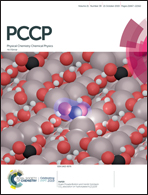Rate dependent structural transition and cycling stability of a lithium-rich layered oxide material†
Abstract
Lithium-rich layered oxide materials, xLi2MnO3·(1 − x)LiMO2 (M = Mn, Fe, Co, Ni, etc.), are a promising candidate for use as cathode materials in the batteries of electric vehicles (EVs). This is due to their high energy density (∼900 W h kg−1), which is larger than those of the currently used commercial cathode materials. Moreover, EV technologies require lithium ion batteries with a high rate performance to achieve short charging times. The high rate property largely depends on the electrochemical properties of the electrodes in these batteries. However, the correlation between the cycling rate, structural stability and electrochemical properties of cathode materials is not clearly understood. In this work, the influence of cycling rate on structural transition behaviors and cycling stability of a 0.5Li2MnO3·0.5LiCoO2 composite-based material was investigated. The experimental results reveal that cycling rates significantly affect the activation of the Li2MnO3 component. A high cycling rate retards Li2MnO3 activation, leading to a smaller spinel phase transition and a higher cycling stability.



 Please wait while we load your content...
Please wait while we load your content...